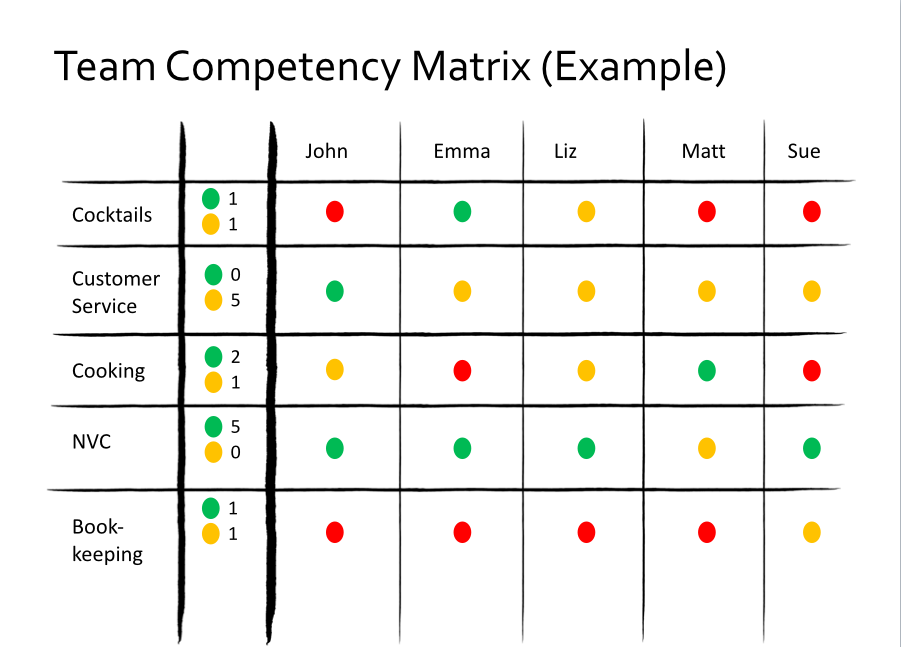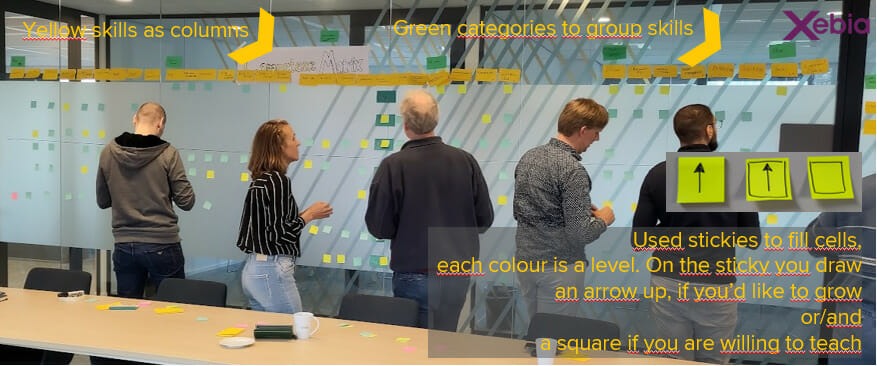Fostering knowledge transfer and becoming T-shaped
Fostering knowledge transfer requires some transparency in distinguished competencies and knowledge areas. And ways to gain knowledge or share knowledge. You become high performing as a team when you have T-shaped people. They have major expertise (the stem) and are familiar with adjacent expertise or parts of the chain. Then peak load can be absorbed, and people have a clue what the others need to fluidly finish the work.
At my current client, we hypothesized that help is not requested or late within the team. Therefore, at least finishing work takes longer lead times than potentially possible. Next, help could accelerate the delivery. Besides, the employee experience is at stake. If you feel stuck too long, that doesn’t help in feeling like a great professional. Due to corona, the team is also not that familiar with each other. So, we’d like to connect about our professional life and learning ambitions.
The value of the competency matrix to foster knowledge transfer
Therefore, it tends to be a clever idea to create a Competency Matrix. This creates transparency in who knows specific skills, domains, or capabilities, which could be both technical and soft skills. So, if you get stuck in a particular area, you have a clue who to reach out to. This could feel safer and faster than waiting for another meeting with the group. There is a list of skills, domains, or capabilities on the list. On the tabs, there are the names of each team member. In the cells, we’ll indicate knowledge levels.

Making knowledge levels transparent fosters giving and receiving help. And enables the team to choose which knowledge areas are too thin spread or low in capacity given the current work.
Get a list of knowledge areas
The list of knowledge should be varied and cover for everyone multiple areas of knowledge. Many people in this company tend to be introvert. So, preparation is key. I asked them already to have a list of knowledge areas with them. Think of areas in which you think you are capable. This could be skill, domain, capability, or tool. In the workshop, these individual lists are merged. Collaboration is best when you are in small groups of a maximum of 5. Then one can’t be passive / withdraw. Then the groups can merge. We’ll merge and create a list of a maximum of 20 knowledge areas. Some themes may arise, or other knowledge areas become subs of grouped skill/domain/capability.
People and skill level
All the names of the people get a column. To indicate skill, we’ll use the categorizing of colors and levels as prescribed on Management 3.0
- Expert: I can teach it. (Green)
- Practitioner: I can do it. (Yellow)
- Novice: What is it? (Red)
As we’ll be onsite, we can work with physical material. I was thinking about something tangible like Lego, stones, magnets, or small stickies to be able to change the first choice, without getting messy when this changes later. I choose mini stickies, but I recommend using one size (normal square). People self asses in parallel by putting stickies in their row.
After people self assessed themselves on the skill level, it’s time to go through the next steps.
- Indicate which knowledge areas you are too thin spread now.
We split up the group into subgroups of 3 people, each with dots to put on the skill if they think it’s too scarce within the team. - Indicate in which knowledge areas you’d like to grow upcoming 6 months
By drawing an arrow up on the skill in your row. This could be on any color: either as a novice or expert, you can learn! - Indicate in which knowledge areas you’d like to grow other
By drawing a box on the skill in your row. This could be on any color, and also if there is already an arrow. Teaching is a great learning stance! - Determine some next steps to make knowledge gain or transfer happen, discussed in three groups with these questions. We had just 5 minutes left, that felt too short. I recommend 10 + 5 minutes review by another set of people
– How can you encourage others?
– When in your process would you do something differently so you could enable knowledge transfer or creation?
– Who can help? a person within the Team? Department? Company? Outside world? What do you need?
Learnings after facilitating the session
1. You have more skills than people, probably. As a result, you can better have skills as columns and people as rows.
2. How to digitize the matrix?
While facilitating the session onsite, analog with stickies, we’d like to log the result digitally. However, I struggled with it. With more than 40 skills, it was too big to photograph. And, people were not that on carpenter level, so the rows floated up and down. Sometimes hard to detect which sticky belonged to which person. More helping lines with tape or more space would mitigate this issue. Independent of the way of digitalizing the artifact, this would help. Additionally, using only squares instead of rectangles makes the matrix less wide.
The best way to digitize is by using the Post-it app (both Android and iOS). The prerequisite is that you used real Post-its (those dimensions) AND there is space between them. Then, the computer recognizes them as such. White walls work best, glass walls stick best. Make your consideration. Even, if written properly, it digitizes the text! You can choose to share it digitally in various file formats, like .xlsx .pptx .pdf, or Miro. Miro works best if you want to iterate on it and stay close to the original.
3. How to foster knowledge transfer in your reality? Follow up on your competency matrix
After the matrix is created, you should act on it. For my organization, this wasn’t obvious what this entails. So, we had a follow-up session (2 hours). We started with a short presentation on formal learning options within the organization. Then some brainstorming about informal learning within or between teams. Then we invented some first steps on the 5 most scarce skills we need to improve capacity on (either broaden or deepen) and on individual aspirations. This was a big team (15p), so we choose to let some people own each scarce skill, and in rounds let other people contribute to drafting a plan. With the individual plans, we first let people think individually and then have two review rounds with peers. When you rank your skills on an individual level, you can draw your T-shaped profile.
Creating this transparency about competencies and ambitions on the personal and team level fosters knowledge transfer. Especially, if you make it tangible how to grow in scarce knowledge areas.

People determine their learning and teaching ambitions on the competency matrix in the workshop.
Knowledge transfer can be fostered. But there is also a culture and attitude about whether it’s safe and effective to ask for or give help. Individuals have their preferences for how to give and receive help. And could vary more, to get what they need or be effective in giving help. Therefore, we complemented the Liberating structure Helping Heuristics, to determine which unwanted patterns are at play. So, fostering knowledge transfer goes like preference. Or at least doesn’t activate resistance.
WHY Helping Heuristics? Purposes
- Reduce/eliminate common errors and traps when people are giving or asking for help.
- Change unwanted giving help patterns that include premature solutions; unneeded advice; adding pressure to force the use of advice; moving to the next steps too quickly; trying too hard not to overhelp.
- Change unwanted asking-for-help patterns that include mistrusting; not sharing real problems; accepting help without ownership; looking for validation, not help; resenting, and not getting enough.
Next, this group will also explore their Moving Motivators. So, motivation can be fostered by preferences. And some concrete applications of fostering are known. The chance people feel valued increases. These three practices will increase the pace of knowledge transfer within the team! Making the team more resilient for the fast delivery of different kinds of work, feeling valued, and onboarding new members quickly.
These practices are fostering knowledge transfer. So, this enables to get T-shaped people which can work smoothly together and absorb peak loads of specific knowledge. This is critical to the success of a DevOps organization and becoming truly Agile. Would you like to have some experienced, trusted advisors on board who have guided other companies to become more agile? Or explore more about Agile transformations? Please contact us, by filling out the contact form at the bottom of this page to get in touch with agile consultants.





